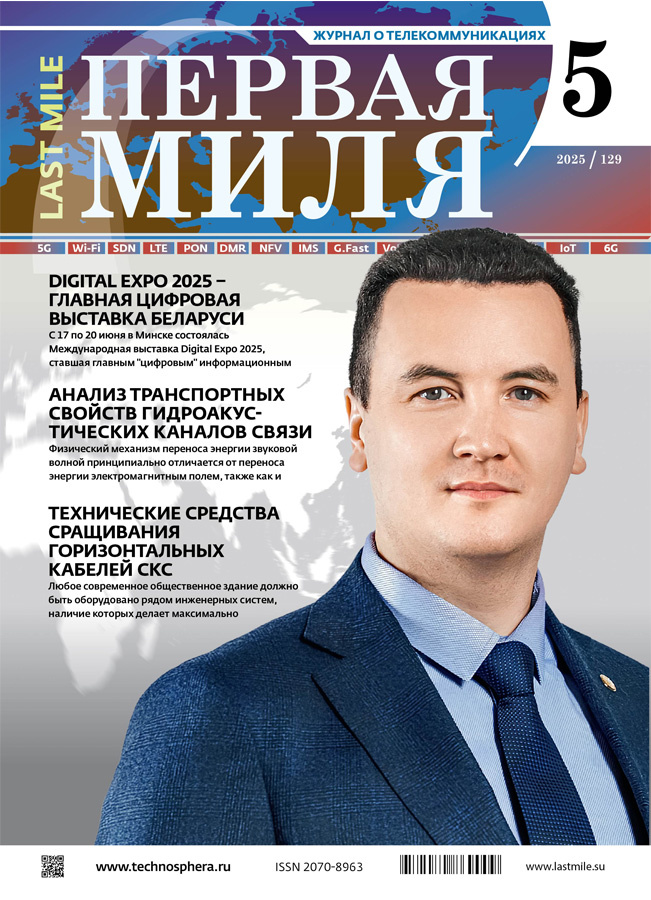No 5 (2025)
EXECUTIVE OPINION
"MARS TECHNOLOGIES" sets a new standard for building alarm systems
 8-13
8-13


ВЫСТАВКИ И КОНФЕРЕНЦИИ
Digital Expo 2025 – the main digital exhibition of Belarus
 16-23
16-23


WIRELESS COMMUNICATION
 24-25
24-25


Positioning in wireless local area networks Wi-Fi standard IEEE 802.11az. Part 2. Model of multi-path radio channel
Abstract
Today, wireless local area network systems using the IEEE 802.11 standard are becoming increasingly widespread to provide radio access for user devices to global networks in various operational scenarios. Along with the access capabilities of the IEEE 802.11az standard at the radio interface level, there is a possibility of implementing high-precision range-finding positioning technology for user devices with decimeter accuracy. This work continues a series of studies dedicated to positioning issues in wireless local area networks using the IEEE 802.11az standard and addresses the problem of investigating the impact of multipath propagation on the accuracy of primary range-finding signal arrival time measurements.
 26-34
26-34


СЕТЕВАЯ ИНФРАСТРУКТУРА
Analysis of the transport properties of hydroacoustic communication channels
Abstract
The paper aim is to analyze water as a transmission medium influence on the transport properties of ultrasonic channels and their throughput potential development. The main destructive factors group influence on channel characteristics such as the energy budget, impulse response nonstationarity and its precorrection effectiveness, the sound focusing tools using efficiency, the Doppler effect reveal and signal-code construction choice are being analyzed.
 36-41
36-41


EXPERT OPINION
We call ourselves the "IT Care" team
 42-43
42-43


CABLES AND PASSIVE EQUIPMENT
On the Pain Points of Telecommunication Fiber Optics Development in Russia
Abstract
The most pressing issues that need to be addressed to achieve technological sovereignty in providing the country with various types of fiber optic cables are briefly presented. Proposals are formulated for the field of telecommunication systems in the Roadmap for the Development of Photonics. The paper is based on a report at the first forum "The Future of Photonics".
 44-46
44-46


Technical means for splicing horizontal SCS cables
Abstract
Based on an analysis of real practice of implementing intra-facility information systems, there is a high probability of changing configuration of stationary lines in the horizontal subsystem of the structured cabling system both during its construction and subsequent operation, making enhancement of pass-throughs relevant. Various options for solving this problem are considered. The feasibility of introducing specialized connecting modules into the standard component base of the SCS is justified.
 48-52
48-52


Fiber optic tilt sensor
Abstract
The demands on sensitivity and stability of fiber optic sensor characteristics are constantly increasing. This paper reviews known fiber optic tilt sensors and discusses a tilt sensor (inclinometer) that can be used to monitor angular deviation of natural and technical objects relative to vertical.
 54-56
54-56


DATA CENTERS
Fiber optic solutions for data centres with packet interfaces based on Ethernet. Part 4. Standardized coherent solutions for data center interconnect (DCI) networks
Abstract
This paper series explores the use of fiber optic solutions to support high transmission rates in data centres, including standardisation of Ethernet solutions for flows from 100 to 1600 Gbps (Part 1); data centre solutions using fiber optic technology (part 2); evolution of pluggable optical transceiver modules (transceivers) for data centres (part 3); standardised coherent solutions for DCI data centre interconnect networks (part 4); connector and cable selection for data centres (part 5).
 58-68
58-68


CHAPTERS OF HISTORY
On the Development of Domestic Radio Communication Means During the First World War (Based on Materials from the A.S. Popov Central Museum of Communication)
Abstract
The paper provides information on the state of the Russian radio industry and the equipping of the army and navy with radio communication means before the First World War; it analyzes the changes that occurred during the war. The results of the analysis lead to conclusion that foreign influence on radio technical production in Russia was minimized. It is noted that a personnel potential was formed, which subsequently became the golden fund of domestic scientists and radio engineers. The paper includes photographic materials from the A.S. Popov Central Museum of Communication archives.
 70-78
70-78







